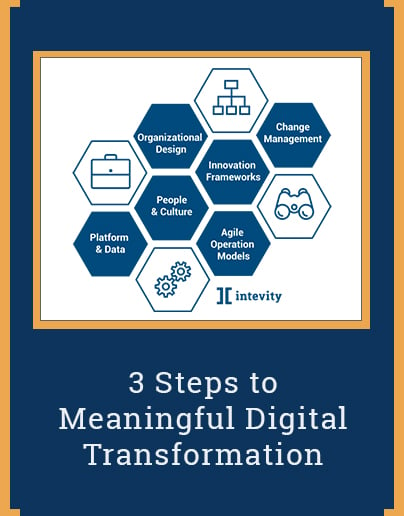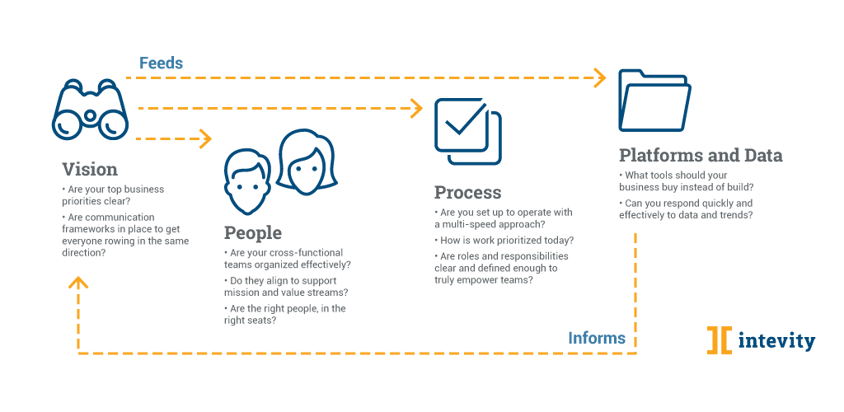Technology has transformed today’s organizations. Workforces are remote, customers demand more and faster, data is accessible across platforms and interfaces, and emerging technologies like artificial intelligence and cloud computing have replaced clunky, legacy technology systems. We now live in a digital world, but are you and your organization thriving or merely surviving?
The truth is despite significant investment, organizations still can’t move fast enough. Teams struggle to collaborate. Systems are unable to adapt to meet changing demands. Business needs pile up and innovative opportunities fall through the cracks. In order to move quicker and make better decisions, organizations need to better adapt to the digital age. Enter: digital transformation.
But what is digital transformation? And why is it so hard to do? Ask three different people and you’ll get 3 different answers. In its simplest form, digital transformation refers to using digital technology to create new and improve existing ways of doing business and serving customers. And regardless of the industry, organizations are recognizing how vital this is for their future.
As technology transforms the world around us, organizations must transform internally as well. Today’s digital organization needs to accelerate business activities, lower operational costs, fast-track innovation, and increase agility and responsiveness to customer needs.
(Note: We define a digital organization or digital business as an organization that uses digital and technology to simplify their business––not overcomplicate it).
The challenge with digital transformation initiatives is knowing where to start and which levers to pull. Reports show that more than half of current companies lack the internal structure and practices to compete with new and emerging digital organizations. Complaints we commonly hear are: “we aren’t moving fast enough” or “we don’t innovate well.”
Organization size doesn’t matter here. Everyone remembers when Blockbuster focused on building more stores while Netflix focused on making video rental more convenient. This highlights that even the largest companies with the biggest budgets struggle. All organizations face a lack of shared vision or teams focused on systems and features rather than solutions and outcomes. A holistic digital strategy is needed to make meaningful and lasting change that enables you to thrive.
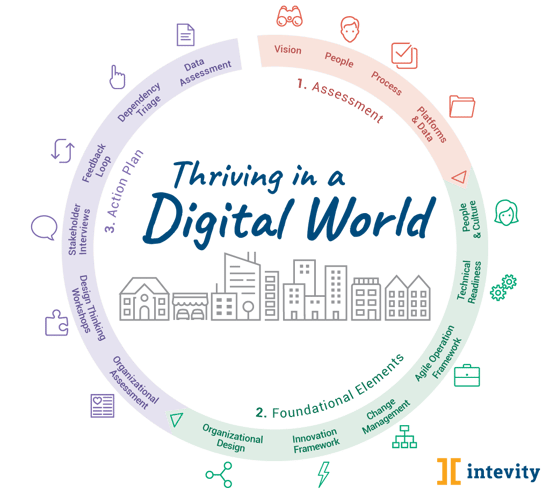
At Intevity, we pose three core questions to clients considering a digital transformation initiative.
Step 1: Assessment
Do you have a good understanding of the current state of your business and platforms?
Digital transformation isn’t simple. It can become a drawn out and costly undertaking. It runs the risk of not demonstrating value for years or ultimately fails to meet business goals. To decrease risk and increase speed-to-market, we recommend organizations take a holistic approach by first stepping back to assess the current state of the business.
When done effectively, an assessment should go well beyond technology and platforms. We’ve found in our work with Fortune 1000 companies that many variables influence the health and efficiency of an organization and its individual teams. These can be distilled down into four buckets: vision, people, process, and platforms and data.
It’s important to understand from the get-go what enables success and what holds back your organization and individual teams (the latter of these is especially telling). You’ll need to call out organizational weaknesses or unnecessary complexities in your processes, and address the technical and human aspects of your business. By using the four themes, you get a holistic understanding of the organization needed to start your transformation with eyes wide open.
Step 2: Foundational Elements
What are the relationships and dependencies between the foundational elements of your digital ecosystem?
Once you know your strengths and weaknesses, it’s time to plan for change. Successful and highly efficient digital organizations are able to orchestrate different changes throughout their business in concert. Too often, businesses try to tackle one component (e.g. innovation frameworks) without acknowledging how other elements are impacted or how everything fits together. This is how symptoms get addressed but not the root cause. Dependencies that wreak havoc downstream are easily missed.
Operational velocity is achieved by applying foundational elements and frameworks, which allow teams to move more quickly and incrementally learn and improve. The key is to develop a roadmap that recognizes and manages dependencies across your organization without slowing down progress.
So how does your organization ensure that it's keeping pace? How do you become one of the few lucky ones that succeed at digital transformation the first time around? Here are six interconnected components to transform your organization into a more agile, cost-efficient, and technology-forward version of itself.
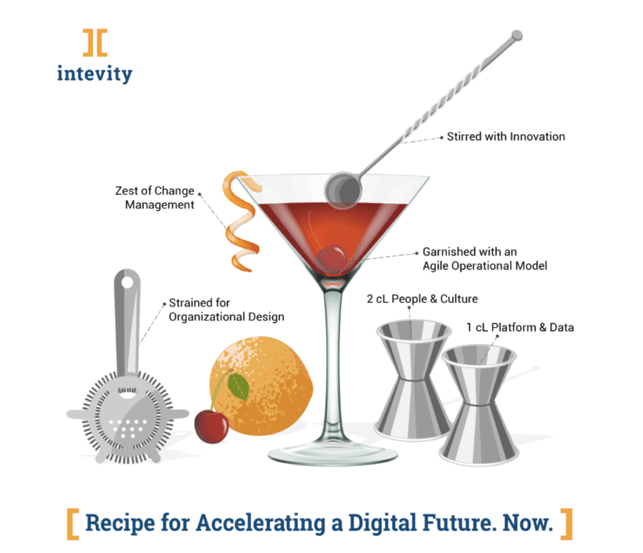
a. Organizational Design
Unless your organization is relatively young, it likely wasn’t designed with digital in mind. As technology brings new strategies and models to your business, your organizational structure and operating model will need an upgrade. Siloed departments and complex hierarchical structures slowing the flow of information can no longer be considered good enough. Your organization needs to be redesigned for agility, multi-department collaboration, and the adoption of new roles. Modern organizations are adopting new roles such as Chief Digital Officer or VP of Digital and adding teams previously deemed unnecessary.
b. Agile Operational Model
Equipped with the design for a more efficient, digitally-capable organization, you will also need a matching operational model. Goals should flow top-down and reach everyone within the organization to ensure holistic alignment and accountability. Lightweight prioritization and governance structures provide just enough direction to drive timely decision-making while not going too far to be considered stifling.
Key managers or team leaders need to be empowered to act with autonomy because every decision can’t take weeks and a committee to decide. Agility and speed in the face of evolving technologies are critical for survival and success. Teams should be cross-functional to break down silos, drive well-round thinking, and organize to deliver solutions––not features.
An agile operational model provides extreme clarity in roles and responsibilities, which are paramount to responding effectively to a changing digital landscape.
c. Innovation Framework
Whether through a pace-layered model or an external incubator, your organization needs an innovation framework to enable long-term growth. Without it, your organization becomes stale and evolving consumer behaviors migrate your customers elsewhere.
As start-ups saturate and disrupt the market, traditional companies must continually look forward and enable the quick and consistent integration of new products and services. This means providing a safe space for experimentation outside of your traditional channels and platforms. This safe space protects your employees, because failures in innovation will happen. And when they do, they shouldn’t disrupt your already established business pipeline.
d. Platforms and Data
With an increasing number of IOT and connected services, organizations are overloaded with data. The problem for most organizations is that they can’t easily access their data and are unsure about what it means to them. Disparate legacy systems are mostly to blame. They make data hard to find and even more tedious to pull insights from. It’s with these concerns that organizations struggle to respond quickly to customer and stakeholder demands.
When investments are made, many companies are not able to validate those investments because they lack the ability to use data as objective measures. Organizations require overarching platform and data strategies that not only serve the present, but also plan for the future. Systems must communicate, services must be shared across departments, and data needs consideration at every step. This is crucial to transforming businesses to being more digital, but many overlook it. They’re distracted by new and shiny innovations. The problem is almost all of these shiny innovations first need a solid platform foundation and data strategy to work.
Make strategizing and optimizing your platform and data infrastructure an immediate “must have” in your digital organization versus a “nice to have.”
e. People and Culture
If your technology platform is the foundation, then your people and culture are the cement binding everything together. Digitally-forward organizations require new skill-sets (e.g. data science, user experience) and behaviors (e.g. agile, transparent). They also need a matching digital culture that attracts and supports new talent, and retrains current employees. This is essential to forming the cohesive, collaborative, and high-performing cross-functional teams that advance organizational goals.
Investing in your people and culture to align with your transformation allows employees to respond smoothly to change, root out inefficiencies, and continually improve and drive accountability and action.
f. Change Management
Building a digital organization requires a multidisciplinary approach. Organizations must continuously learn, adapt, and implement new ideas at a rapid pace. Changing initiatives that bring new technologies and processes can be viewed by employees as threatening, intimidating, or unnecessary. It’s not enough to tell two groups to work together and hope that that alone will break down any silos between them.
Aligning stakeholders and employees on a shared vision of the future will help frame your organizational transformation as more than just “digital.” Manage change deliberately––starting with true empathy and transparency––to de-risk internal changes and increase their ability to succeed from the start.
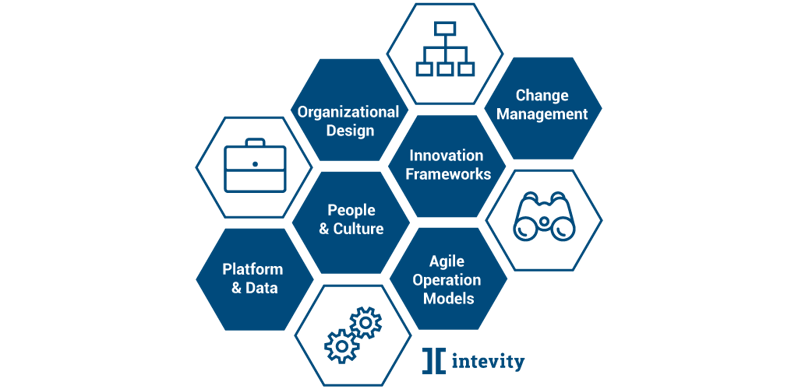
Step 3: Create an Action Plan
What is your path forward and is it actionable, measurable, and fully aligned with your company’s overall vision and strategy?
You’ve done the research and you’ve created a plan. Now, it’s time to apply it. Be cautious about blindly implementing frameworks that have worked for others (e.g. Spotify Squads) without considering your organization’s unique business needs and culture. Your actions should be tailored to your organization. This may mean restructuring teams to better align to value streams, conducting a series of design thinking workshops to de-risk an idea or problem, or setting up an innovation accelerator.
The key is putting a plan in place that is clear, measurable and aligned to the mission of the organization.
